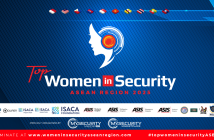 Welcome to another special edition of ASM. In this issue we expand our international and Asia Pacific focus, continue an editorial evaluation of national licensing and profile ‘Women in Security’ who will inspire anyone, whether in the security industry or otherwise.
Welcome to another special edition of ASM. In this issue we expand our international and Asia Pacific focus, continue an editorial evaluation of national licensing and profile ‘Women in Security’ who will inspire anyone, whether in the security industry or otherwise.
There has naturally been a great deal of attention given to the emerging GFC II and recession economies in Europe and US. The impact of these trends have again highlighted the global importance of the Asia Pacific Region. China is now the second biggest world economy and Asia forecast to be the economic region of power for this century.
ASM has reached out to our security colleagues operating throughout Asia. The calibre of these professionals, their enthusiasm and range of articles coming our way is fantastic. We provide examples in this issue, with Crisis Management in South East Asia, Kidnapping in the Philippines and highlight workshop outcomes from the United Nations Office on Drugs and Crime–International Telecommunication Union (UNODC–ITU) “Asia-Pacific Regional Workshop on Fighting Cybercrime” held in Seoul, Republic of Korea.
At a national level, I have had the opportunity of speaking to a number of eminent professionals and industry leaders about the issue of national licensing. The industry is overwhelmingly in support of the reform. Indeed, ASM has now started to seek out our national and state political leaders to get their policy positions on this important issue. Even The Hon. Penny Wong is not immune in her role as the Federal Finance and Deregulation Minister. Reforming Australian industry in line with current taxation reform, promising to reduce unnecessary taxes and charges and reward business with increases in productivity does not exclude the security industry. National security licensing regimes will indeed reduce costs to business, improve standards and promote efficiencies and greater productivity.
The utopia is for the Australian security industry is to have a national regulator, or “one-stop shop,” to help with the governance, accountability and transparency of security enterprises. Its main functions are determining the security status of organisations, maintaining a centralised financial and governance reporting portal and providing other information, education and advice to the sector. Done well, the national model should improve the public confidence in the security industry and open lines of communication between state and federal law enforcement.
In addition, government must strike the right balance between implementing rapid reform and ensuring the sector can participate in the consultation process over the next few years and adjust to change.
Existing state regulators, namely police and consumer trade offices, rarely seek wide input to their individual state reforms. Rarely do they even take a traditional consultative approach of detailed papers and submissions. Indeed, in NSW they are moving away from conducting roundtable discussions with sector leaders, so fewer have an opportunity for comment. The aim of exploring issues more deeply and widely, indeed with a holistic approach, is ignored for what is otherwise reactionary and worse still, still alleged to be ‘reform’. This approach is certainly highlighted in our Beyond 2012 series and well done to ASIAL for pointing out the lack of collaboration with industry by the NSW Government.
Granted, it is a big challenge to build a national regulatory body based on a national licensing model. The advantages will best come from a hybrid structure that uses back-office functions provided by each State, as they presently do, but its operations aim to minimise government bureaucracy, maximise probity and allow the security sector the freedom to operate professionally, nationally.
It has been aptly pointed out to me however, that the security industry and law enforcement agencies do business very differently. It may explain why there is at times a degree of perceived competition between the two. As a stark example, at the start of each financial year, our law enforcement agencies (LEAs) are given a budget to spend, or in simple terms a ‘bucket of money’. LEAs are then required to expense these funds for the remainder of the year. Rarely, if ever, will you find our LEAs coming in under budget. In contrast, security companies and businesses start with a budget but without a defined money pool. Police are not actively seeking to be efficient, whilst the security industry struggles to balance efficiency with ill-defined revenue forecasts and increasing business costs. In these financial environments, the practice of ‘plural policing’ is highly likely to continue as it has already been emerging nationally. Government regulators need to adapt just as fast as the industry. ASM will continue to examine these issues in greater detail and also welcomes contributions to highlight examples of ‘plural policing’ in Australia.
Security professionals require the capacity to deal with ever present global trends, regional developments and national challenges. The strategies adopted in response or anticipation are naturally designed to minimise the impact of risk and maintain the highest degree of resilience. Strategies need to be monitored, communicated and executed. I trust ASM will continue to provide a great deal of valuable information and guidance to assist our security professionals do just that.
We encourage you to visit the brand new ASM website (www.malaysiasecuritymagazine.com) and also take a look at MySecurity TV, now with over 30 on-camera interviews with industry experts and leading vendors – a TV channel now quite unique in Australia and Asia Pacific.
Enjoy the read and I welcome and look forward to hearing your feedback.
Yours sincerely,
Chris Cubbage.




